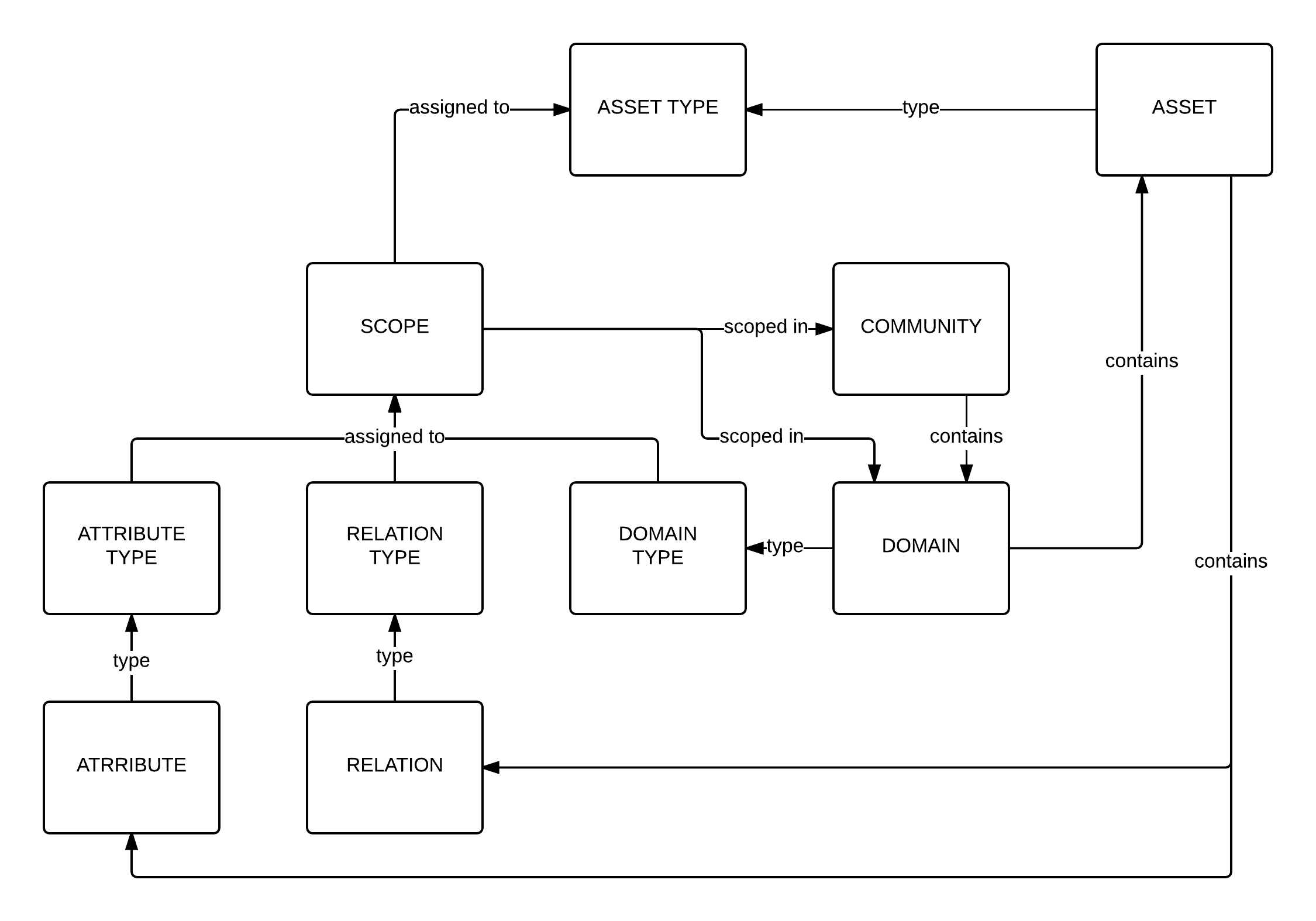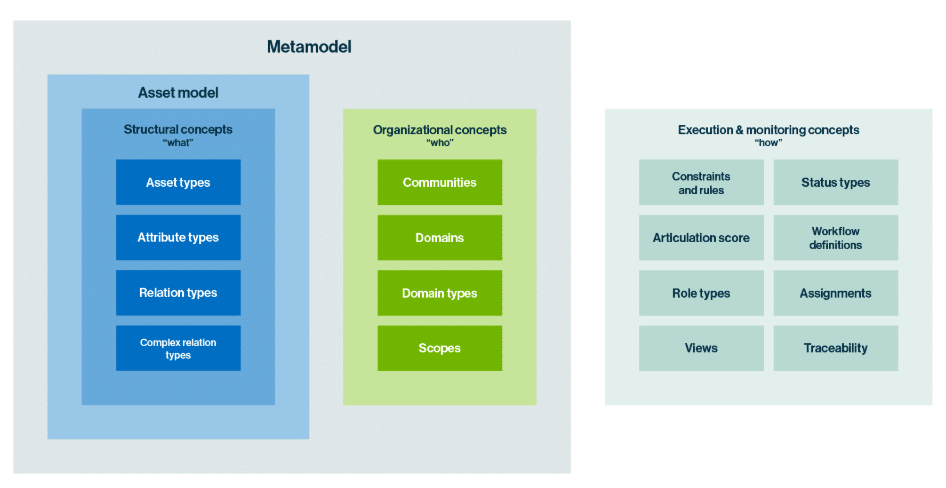To effectively use Collibra, it is important to understand its core concepts and how they are connected.
Concepts
| Concept | Description |
|---|---|
| Community
|
A community is a high-level organizational structure that groups subcommunities and domains. It often corresponds to the functional divisions in a company and works best when aligned with the company's governance organization. Communities represent broader areas of responsibility, such as an entire department or business unit. They help manage access and responsibilities at a higher level. |
| Domain
|
A domain is a logical grouping of assets that belongs to only one community. It has a unique name within its community and is based on a single domain type. A domain acts as a container for related assets of specific asset types. For example, a domain can group all business terms for a specific business area or all data sets for a particular system. |
| Domain type | A domain type defines the semantics of a domain, similar to a template. It defines which types of assets can be created within the domain. For example, the Business Glossary domain type may allow only Business Term assets. |
| Scope |
A scope is a selection of communities and domains that you can assign to one or more asset types. In a scope, you can define domain types, attribute types, relation types, and other configurations. It is an efficient way to configure asset types for specific group needs without cluttering Collibra with custom asset types. |
| Asset type |
An asset belongs to a specific category called an asset type. An asset type defines the semantics of an asset, similar to a template. It defines which attribute types and relation types the asset can have. Scopes are assigned to asset types. An asset type defines the information and behavior of assets, including where they can be organized and what information can be collected about them. For example, the Business Term asset type is used to define and manage business vocabulary, whereas the Data Set asset type represents a collection of data. An asset type can be added only to a specific domain type, ensuring that assets are meaningfully organized. Collibra uses five out-of-the-box parent asset types:
|
| Asset |
An asset is a core building block for which you want to capture information. It belongs to only one domain and has a unique name within the domain. It represents an object such as a data set, business term, or report. Each asset has a type, such as a Column asset or a Table asset, which defines its purpose and structure. An asset is an instance of only one asset type. |
| Attribute type | An attribute type defines the class of information that an attribute contains. It is assigned to an asset type through a global or scoped assignment. |
| Attribute |
An attribute is a specific piece of information about an asset, such as the definition or the effective start date. An asset can have many attributes. An attribute is an instance of an attribute type. |
| Relation type |
A relation type specifies the type of relation between two asset types. It is bidirectional, connecting a head asset type to a tail asset type and the other way around. |
| Relation |
A relation is a link between assets. It defines how assets are related to each other. For example, a Column asset can be related to a Table asset. These relationships help you understand the context and lineage of your data. An asset can have many relations. A relation is an instance of a relation type. |
| Complex relation type |
A complex relation is a type of relation that enables you to create many-to-many relations as well as capture attributes (such as description or priority). It can be regarded as objectified associations. A complex relation type is defined by its name, description, a collection of relation types, and a collection of attribute types. |
How Collibra building blocks are connected
To create an unbeatable data governance model, it is important to understand how the basic building blocks are related.

An organization's operating model
Your Collibra environment is made up of resources such as assets, domains, and communities, which have assigned types and characteristics. When organized together, they form an operating model.

Some of the places where your organization’s operating model is represented are:
- Browse pane: Shows a list of communities with subcommunities and domains nested underneath, on the Organization tab.
- Diagrams: Shows a visual representation of how an asset is related to other assets.
Roles and permissions
Roles define who can perform which actions on assets, such as viewing, editing, or approving them. Permissions are assigned to roles to ensure proper governance and accountability. It also supports segregation of duties to ensure no single user has excessive control.
-
Roles: Roles are collections of permissions that define which actions users can perform. Roles can be assigned at the following levels:
- Global roles: These roles apply across the entire Collibra Platform. For example, the Sysadmin global role grants platform-wide permissions, such as managing users and groups or configuring platform settings.
- Resource roles: These roles apply to specific resources, such as communities, domains, or assets. For example, the Community Manager resource role may allow a user to manage all domains and assets within a specific community.
-
Permissions: Permissions define which actions users or groups can perform on specific resources, such as communities, domains, or assets. They are a key component of access control and governance, ensuring that users have the appropriate level of access to perform their responsibilities while maintaining data security and compliance.
- Global permissions: These permissions apply across the entire Collibra Platform or a product, and aren't tied to specific resources. For example, global permissions allow users to manage workflows, configure platform settings, or create and manage user accounts.
- Resource permissions: These permissions are specific to individual resources, such as communities, domains, or assets. They determine which actions users can perform on those resources, such as viewing, editing, or deleting them.
NoteThe View permission is the most basic and essential permission in Collibra. It allows users to see a resource, such as a community, domain, or asset, in Collibra. Without the View permission, users can't access or interact with the resource in any way. The View permission is often a prerequisite for other permissions, such as Edit or Delete, as users must first be able to see a resource before they can perform additional actions on it.
For example:- If a user has the View permission for a community, they can see the community and its contents, such as domains and assets.
- If a user doesn't have the View permission for a domain, the domain is hidden from them.
-
Inheritance: Resource permissions are often inherited from higher levels. For example, if a user has the Update resource permission at the domain level, they automatically have the Update resource permission for all assets within that domain. However, permissions can also be customized at the asset level to override inheritance.
-
Groups: Groups allows administrators to manage permissions for multiple users at once. Instead of giving each user a role, the user is assigned to a group, which then is given a role. For example, you can assign a role to a group, and all members of that group will inherit the associated permissions.
-
Statuses: Statuses indicate the current status of an asset, such as Draft, Approved, or Deprecated. They help track the lifecycle of assets and ensure proper governance.
-
Workflows: Workflows automate processes, such as approving a new business term or reviewing a data set. They ensure consistency and efficiency in managing your data governance tasks.